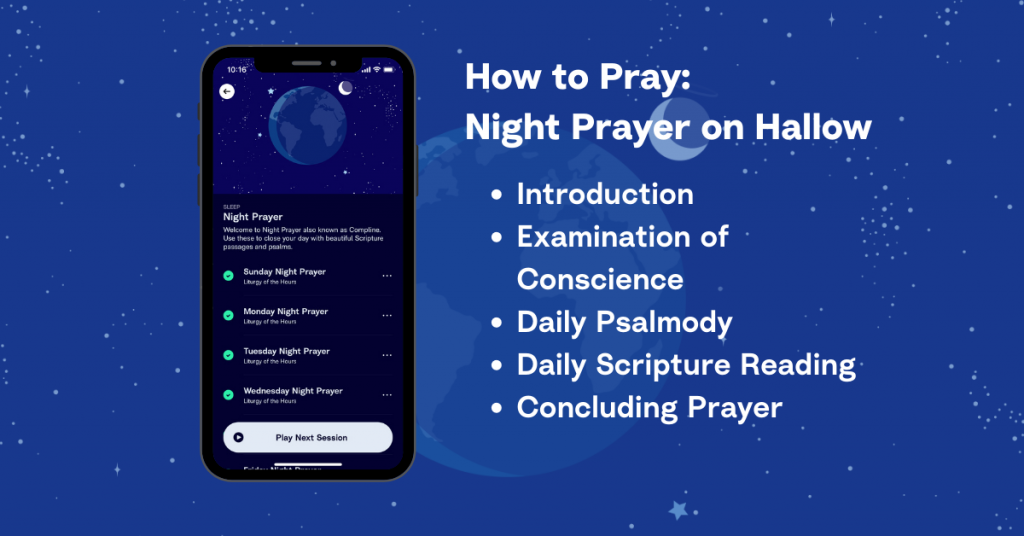Liturgy of the Hours, also called the Divine Office or the Breviary, helps us live out the call to “pray without ceasing.”
Rejoice always, pray without ceasing, give thanks in all circumstances; for this is the will of God in Christ Jesus for you.
1 Thessalonians 5:16-18
Table of Contents
- My Introduction to Liturgy of the Hours
- Background: Liturgy of the Hours
- Hours of Liturgy of the Hours
- Office of the Readings
- Liturgy of the Hours at Night
- How to Pray Liturgy of the Hours: Night Prayer
- More Prayer Resources
My Introduction to the Liturgy of the Hours
When I was in college, one of my friends discerned to step out of the seminary. While adjusting back to normal college life, the biggest thing he missed was prayer. Specifically, he missed how prayer structured his days through the Liturgy of the Hours, as seminarians pray this together each day.
The Liturgy of the Hours is a form of prayer that follows the rhythm of each day through psalms, Scripture, and prayers. Morning Prayer begins the day. Then, Daytime Prayers are said at mid-morning, noon, and in the afternoon. Evening Prayer is said at the end of the day’s work. Lastly, Night Prayer is said before going to sleep to offer up the day to God.
Priests and religious pray these prayers every day, but all of us are invited to do so as well! I was introduced to the Liturgy of the Hours when the above-mentioned friend started getting a group together to pray Night Prayer. We fumbled through thick and confusing books (there are so many prayers to keep track of!) and sang the Hail, Holy Queen off-key, but we made it through, and the beauty of the Liturgy of the Hours was made known to us.
Background: Liturgy of the Hours
Historical Roots
Praying at select hours of the day, multiple times a day, has roots in the Jewish tradition. The Psalms, in particular, were prayed throughout the day. We even know that Jesus prayed with the Psalms, as he most famously prayed Psalm 22 on Cross: “My God, my God, why have you abandoned me?”
The Divine Office, which draws from the Old and New Testaments as well as hymns and Catholic prayers, likely originated out of this practice among the early Church.
“In the early days of the Church, the first Christians were Jewish, and the Acts of the Apostles depicts them not only participating in the breaking of the bread, but also going to the synagogue and Temple to worship. This included traditional prayer services at the third, sixth and ninth hours of the day, our 9 o’clock in the morning, noon and 3 o’clock in the afternoon.”
Mary Bazzett for Catholic Culture
The growth of monasticism brought about various traditions in daily prayer, with many relying on the Divine Office framework. St. Benedict of Nursia famously instructed people to pray all 150 Psalms each week in The Rule. For this reason, the Benedictines call the Divine Office Opus Dei, Latin for the “Work of God.”
This disciplined prayer tradition supports St. Benedict’s desire to pray regularly, pray with Scripture, and pray throughout the day while working. The Rule of St. Benedict famously begins,
“Listen, my son, to the Master’s instructions and attend to them with the ear of your heart.”
Vatican II Revision
During Vatican II, the Church revised the traditional Divine Office into what we know as the Liturgy of the Hours for greater use in public and among lay persons. Learn more about this revision in Sacrosanctum Concilium, promulgated by Pope Paul VI in 1963.
This led to a lengthening of the cycle, thus shortening the time in daily prayer in the Liturgy of the Hours. The original Divine Office cycled through all 150 Psalms in one week, whereas the Liturgy of the Hours today cycles through all 150 Psalms in four weeks (one month). There are other differences as well, though this was the most prominent transition.
Hours of Liturgy of the Hours
Seven times a day I praise you because your judgments are righteous. Lovers of your law have much peace; for them there is no stumbling block.
Psalms 119:164-165
It’s incredible to think that around the world, thousands of people are praying the same prayers, offering up their work and days to God. And these prayers have been prayed over and over again for years, and yet they still pertain to our lives today. As you pray, at once, you are connected in the present to those praying around the world, and you are connected to the past, to the people who lived before us, who loved and struggled and prayed just as we do today.
Pre-Vatican II Breviary or Divine Office
- 3 a.m. – Lauds
- 6 a.m. – Prime
- 9 a.m. – Terce
- Noon – Sext
- 3 p.m. – None
- 6 p.m. (Evening Prayer) – Vespers
- 9 p.m. (Night Prayer) – Compline
- Midnight – Matins
Post-Vatican II Liturgy of the Hours
- Office of Readings
- Morning Prayer
- Daytime Prayer
- Evening Prayer
- Night Prayer
Office of the Readings
Office of the Readings includes a reading from the Psalms with Antiphons, various prayers, a reading from the Old or New Testament, and a reading from the tradition of the Church, such as the writing of a saint, pope, or Doctor of the Church. A few authors you might be familiar with are St. Pope John Paul II, St. Augustine, or St. Teresa of Ávila.
Night Prayer
For the Lord is your shelter and refuge; you have made the Most High your dwelling-place.
Psalm 91
Formally, Night Prayer is called “Compline,” which comes from the Latin verb complete, meaning to “fill up.” Based on its formal etymology, Compline allows you to “fill your vessel” with prayer before you sleep. It generally takes about 8 – 10 minutes to pray in full. Night prayer follows a seven-day sequence, one for each day of the week, with a consistent structure; the Psalms and other Scripture passages change throughout the cycle. It is always the last prayer of the day, traditionally prayed right before sleep.
Night prayer is the last prayer of the day, said before retiring, even if that is after midnight.”
The General Instructions on the Liturgy of the Hours
So, why pray Night Prayer?
First, to rest easy with the Lord; ending your day in prayer with God helps you to rest in His presence before you fall asleep. Second, to call on God; you can discover a sense of calm, examine your conscience, meditate on Scripture, and grow closer to Mary. And third, to relieve your burdens; this time in prayer might help relieve any worries on your heart and mind before you fall asleep, whether you’re thinking about today or tomorrow. This prayerful act reminds you that today was a gift from God, and tomorrow is, too.
Here’s an outline to get you started with Night Prayer and help you follow along. The italicized parts should be said together as you pray.
How to Pray: The Liturgy of the Hours – Night Prayer
Time needed: 15 minutes
How to Pray The Liturgy of the Hours: Night Prayer
- Begin the Prayer (Introduction)
God, come to my assistance. (Make the Sign of the Cross)
Lord, make haste to help me.
Glory to the Father, and to the Son, and to the Holy Spirit,
As it was in the beginning, is now, and will be for ever. Amen. Alleluia. - The Examination of Conscience
Take a few moments to examine your conscience from the day. This is similar to the Ignatian practice of the Daily Examen.
Let’s ask God for forgiveness as we pray.
I confess to almighty God and to you my brothers and sisters, that I have greatly sinned in my thoughts and in my words, in what I have done and in what I have failed to do through my fault, through my fault, through my most grievous fault. Therefore I ask the blessed Mary ever-virgin, and all the angels and saints, and you my brothers and sisters, to pray for me to the Lord our God. - Recite the Daily Psalmody
Antiphon (a short phrase taken from the Psalm)
Psalm (changes each day)
Pray – Glory to the Father, and to the Son, and to the Holy Spirit. As it was in the beginning, is now, and will be forever, Amen. Repeat antiphon - Read the Daily Scripture
Read the daily Scripture passage for the day. This will change daily. The Responsory and Gospel Canticle follow.
Responsory
Into your hands, Lord, I commend my spirit.
Into your hands, Lord, I commend my spirit.
You have redeemed us, Lord God of truth.
I commend my spirit.
Glory to the Father, and to the Son, and to the Holy Spirit.
Into your hands, Lord, I commend my spirit.
Gospel Canticle
This is from the Song of Simeon in Luke Ch. 2 (often sung).
Antiphon – Protect us, Lord, as we stay awake; watch over us as we sleep; that awake, we may keep watch with Christ, and asleep, rest in his peace.
Pray – Lord, now you let your servant go in peace; your word has been fulfilled. My own eyes have seen the salvation which you have prepared in the sight of every people. A light to reveal you to the nations and the glory of your people, Israel.
Pray – Glory to the Father, and to the Son, and to the Holy Spirit. As it was in the beginning is now and will be forever. Amen.
Repeat antiphon –
Protect us, Lord, as we stay awake; watch over us as we sleep; that awake, we may keep watch with Christ, and asleep, rest in his peace. - Say (or Sing) a song in honor of the Blessed Virgin Mary
You can choose other prayers, such as the Hail Mary, and this is often sung.
Hail, holy Queen, mother of mercy, our life, our sweetness, and our hope. To you do we cry, poor banished children of Eve. To you do we send up our sighs mourning and weeping in this valley of tears. Turn then, most gracious advocate, your eyes of mercy toward us, and after this our exile, show unto us the blessed fruit of your womb, Jesus. O clement, o loving, o sweet Virgin Mary. Amen.
In the name of the Father, and of the Son, and of the Holy Spirit. Amen.
Hallow offers Morning Psalms with Bishop Robert Barron and Night Prayer with Hallow Guides for every day of the week. Consider setting up a Routine when you wake up and before bed to begin and end the day with God (Me Tab > Routines > + > Add Content). We look forward to praying with you!
We look forward to praying with you!

